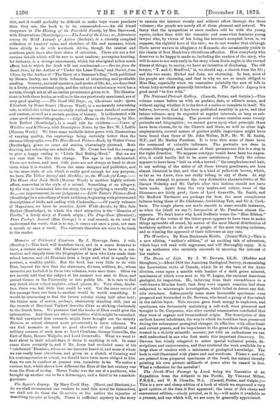The Dawn of Life. By J. W. Dawson. LL.D. (Hodder
and Stoughton.)—About 1858 the American Geological Survey, in examining the Laurentian rocks of Canada, which lie at the base of the Azoic division, came upon a marble with laminas of a dark green mineral, specimens of which were sent to Sir W. Logan, the eminent American geologist, for inspection. He, believing from their resemblance to a well-known Silurian fossil, that they were organic remains, had them subjected to microscopic investigation, which failed to detect any defi- nite structure. Subsequently some more favourable specimens were prepared and forwarded to Dr. Dawson, who found a group of fine tubuli in the calcite layer. This success gave fresh energy to explorers, and specimens, one fortunately containing a cell-wall, were procured and brought to Dr. Carpenter, who after careful examination concluded that they were of organic and foraminiferal origin. The description of this earliest known inhabitant, the way in which its fossil has been preserved during the subsequent geological changes, its affinities with other fossil and extant genera, and its importance in the great chain of life, are he a treated in a strictly scientific manner, yet with an enthusiasm we can well understand in one who first made this important discovery. Dr. Dawson• has wisely relegated to notes special technical points, de- scriptions, and controversies, and thus rendered the work available for a large class of readers with a minimum of geological knowledge. The book is well illustrated with plates and and woodcuts. Plates v. and vii. are printed from prepared specimens of the fossil, the animal thereby painting his own picture milliards of years after he ceased to live. What a reflection for the moralist I






































 Previous page
Previous page